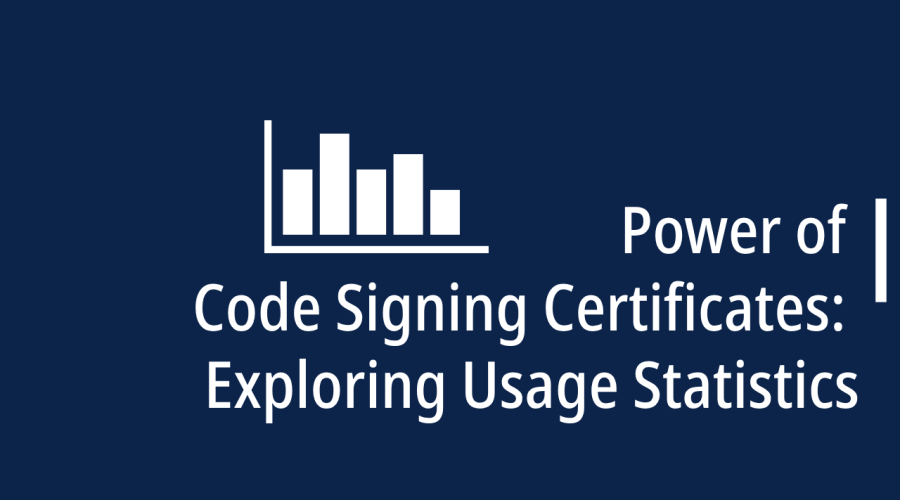Code Signing certificates have emerged as a critical tool in ensuring trust and security for both developers and end-users. These digital certificates play a pivotal role in guaranteeing the authenticity and integrity of software, and their usage has grown exponentially over the years. In this blog, we delve into the fascinating world of Code Signing certificates, shedding light on their significance and exploring the latest usage statistics.
Understanding Code Signing Certificates
Before we dive into the statistics, let’s grasp the fundamental concept of Code Signing certificates. At their core, these certificates are cryptographic tools that developers use to digitally sign their software and applications. By affixing a unique digital signature to their code, developers assure users that the software has not been tampered with or altered since it was signed. This trust factor is vital in a world where malware, viruses, and data breaches are constant threats.
The Proliferation of Code Signing Certificates
Code Signing certificates have witnessed a remarkable surge in usage over the past few years, owing to the following factors:
- Security Consciousness: In an era when security breaches make headlines on a regular basis, developers and organizations are more vigilant than ever about the safety of their software. Code Signing certificates are seen as an essential security measure to prevent unauthorized code execution.
- App Stores and Platforms: Popular app distribution platforms, such as the Apple App Store, Google Play Store, and Microsoft Store, require developers to sign their apps with Code Signing certificates to ensure safety for their users.
- Regulatory Compliance: Many industries, including healthcare, finance, and government, are subject to stringent regulatory requirements. Code Signing certificates help organizations meet these requirements by ensuring the authenticity and integrity of their software.
Key Usage Statistics
To understand the widespread adoption of Code Signing certificates, let’s delve into some intriguing usage statistics:
1. Industry Verticals:
- Healthcare: The healthcare sector has seen a significant uptick in the use of Code Signing certificates, driven by the need to secure electronic health records and medical applications.
- Finance: Financial institutions, including banks and insurance companies, are investing heavily in Code Signing certificates to protect sensitive customer data and financial transactions.
2. Code Signing Algorithms:
- SHA-256: The SHA-256 algorithm is currently the most widely used for Code Signing certificates due to its robust security features.
3. Geographic Distribution:
- North America: The United States and Canada are at the forefront of Code Signing certificate usage, with a high concentration of software development companies.
- Europe: European countries, especially Germany and the United Kingdom, have also witnessed significant adoption.
4. Mobile App Development:
- In the mobile app development domain, the use of Code Signing certificates is practically ubiquitous. Virtually all apps on major app stores are signed to guarantee their authenticity.
5. IoT and Embedded Systems:
- Code Signing certificates have made their way into the Internet of Things (IoT) and embedded systems to ensure the security of interconnected devices.
Benefits and Future Trends
The statistics clearly highlight the importance of Code Signing certificates in today’s digital landscape. Their benefits extend beyond security to encompass enhanced user trust, reduced risks of malware infections, and regulatory compliance.
Looking ahead, we can anticipate several future trends:
- Quantum-Resistant Algorithms: As quantum computing advances, there will be a growing need for quantum-resistant Code Signing algorithms to safeguard the security of digital signatures.
- Automation: The process of Code Signing is likely to become more automated and integrated into development pipelines, reducing the margin for human error.
- Increased Adoption in Emerging Markets: Emerging markets, with their growing software development sectors, are expected to see increased Code Signing certificate adoption.
In conclusion, Code Signing certificates have become indispensable in ensuring the security and trustworthiness of software and applications. Their widespread adoption across various industries and regions underlines their role in the digital ecosystem. As technology continues to evolve, the significance of Code Signing certificates is only set to grow, making them an essential tool for both developers and users in the digital age.

Gloria Bradford is a renowned expert in the field of encryption, widely recognized for her pioneering work in safeguarding digital information and communication. With a career spanning over two decades, she has played a pivotal role in shaping the landscape of cybersecurity and data protection.
Throughout her illustrious career, Gloria has occupied key roles in both private industry and government agencies. Her expertise has been instrumental in developing state-of-the-art encryption and code signing technologies that have fortified digital fortresses against the relentless tide of cyber threats.
